Delicious Vinyl: Japan's Plastic Food Replicas
Like any Michelin chef worth his salt, the Captain - yes, he has a number of talents - knows that a dish's appearance is as important as its taste. In Japan, it is perhaps even more vital.
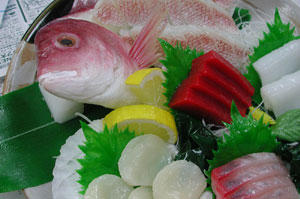 Read on, folks, this week the Captain is pouring chemicals and applying paint in a shop that makes the replica foods that assist diners in selecting what they want to eat. The only certainty is that you will leave with an empty stomach.
Read on, folks, this week the Captain is pouring chemicals and applying paint in a shop that makes the replica foods that assist diners in selecting what they want to eat. The only certainty is that you will leave with an empty stomach.
Image is entirely everything.
Fumiyoshi Nagao raises the cooked fish by the fin and lets it flop back down on the dinner plate, causing the shredded daikon radish and other garnishes to jiggle just a bit. Slices of various sashimi, in sets of four, fill out the rest of the plate.
"Maybe it has to be a little higher," the 54-year-old supposes, grabbing the fish's dorsal fin and tilting it upward. "Or maybe the daikon has to be moved slightly. The image of the dish is often a problem. The customer always wants it to look like the original - or even better."
Though it might seem like it, a cooking lesson this is not.
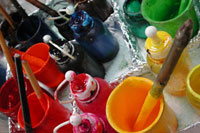 The fish is actually made of plastic - vinyl chloride, to be exact - and the location is not an eatery of any kind but rather a tiny shop in Otsuka, Tokyo. Nagao's company, Nagao Shoken, creates the plastic food models often seen lined up on shelves in dusty glass cabinets at entrances to restaurants in Japan.
The fish is actually made of plastic - vinyl chloride, to be exact - and the location is not an eatery of any kind but rather a tiny shop in Otsuka, Tokyo. Nagao's company, Nagao Shoken, creates the plastic food models often seen lined up on shelves in dusty glass cabinets at entrances to restaurants in Japan.
Even with his work resembling food, his shop is quite different from a kitchen: rubbery silicon molds lie in pyramids off to the side; dozens of dish soap bottles sit covered in layers of multi-colored goop; brushes, cans of paint labeled with names of vegetables, and jars of chemicals cover nearly every square centimeter of the tops of the shop's two central tables.
Nagao is, as he says, "a replica craftsman." His work is intended to remove doubt about a dish's quality from the diner's mind and lure him into a purchase from his client, the establishment itself.
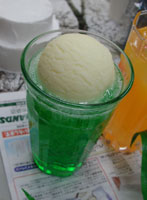 "When we as customers go to restaurants it is easy for us to see what we will get with the models," he explains, his pants and shirt covered in small paint drips. "Otherwise, we would just be guessing from the menu."
"When we as customers go to restaurants it is easy for us to see what we will get with the models," he explains, his pants and shirt covered in small paint drips. "Otherwise, we would just be guessing from the menu."
It is a Japanese process that has been perfected over the past ninety years, with the end products becoming an expected element in the dining experience.
From soup to nut, the creation of the models is surprisingly easy and fast.
Nagao's clients send him the original menu items they need replicated along with photos. Silicon is poured around each item within the dish - say, a hamburger patty or a slice of fish - in a saucepan atop a stove burner. The silicon solidifies into a mold in the shape of the original food.
Liquid vinyl, in whatever color is necessary, is then poured into the empty mold. The mold is set in an oven where the vinyl will harden for between ten and 30 minutes. An air gun is used to pop the vinyl chunks loose.
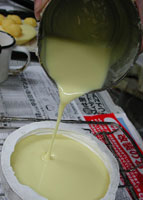 The devil of this work is in the details. "After making a mold in silicon, getting the appropriate detail in the vinyl model is difficult," says Nagao. "For example, the spines in the fin of a fish."
The devil of this work is in the details. "After making a mold in silicon, getting the appropriate detail in the vinyl model is difficult," says Nagao. "For example, the spines in the fin of a fish."
Any excess vinyl buildup is trimmed off with scissors. Oil-based paints in tubes and jars add details with the photos working as guides. Airbrushes are used to provide consistency in the paint and ensure a natural look.
The menu item is then assembled from the various vinyl pieces. For the aforementioned fish, the individual parts - the fins, tail, body, and head - are carefully placed among the vinyl stock items Nagao has in bags in his shop; in this case, they are shredded daikon, other leafy garnishes, and pieces of sashimi. A similar procedure is performed for a hamburger bun, patty, and side of fries. The entire process takes only a few hours.
Non-solid items, such as pork ramen or glasses of frothy beer, bypass the mold stage. For ramen, it is a matter of mixing a number the stock on hand. Vinyl noodles, vinyl roast pork (chashu), and vinyl onions (negi) are blended in a shallow dish of vinyl broth that is colored to match the ramen soup base needed, perhaps shoyu (soy) or tonkotsu (boiled pork bones). After leaving the oven, the final product, which is about an inch thick, is removed from the dish and set into a regular ramen bowl.
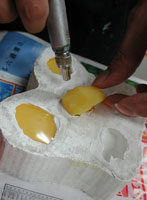 Nagao's customers are very finicky. As he works, he always pays attention to how light coming through the glass display will affect the color of his products. As well, he ensures that his stock items come in unending variety. The fake roast pork pieces, for example, even have the fat marbled in different locations.
Nagao's customers are very finicky. As he works, he always pays attention to how light coming through the glass display will affect the color of his products. As well, he ensures that his stock items come in unending variety. The fake roast pork pieces, for example, even have the fat marbled in different locations.
The menu items are all made-to-order so repeat use of the molds is not certain, though it does happen. "Last week a movie theater chain wanted more than 100 hot dogs," Nagao explains.
The volume of work varies each week. It is dependent on the complexity of exactly what has been ordered. But Nagao guesses he might put together between one hundred and 200 menu items each week.
The cost varies considerably. The aforementioned plate of fish will run 28,000 yen. A single sushi piece fetches 800 yen, though that of ebi (shrimp) is a tad more (1,000 yen). Ceramic serving plates or wood platters are extra.
Nagao and his staff of a half-dozen create an environment similar to that of an art class in the one-room shop, which is really the first floor of Nagao's home.
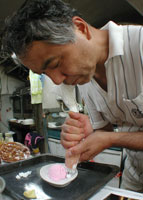 "There's no balance," an exasperated Nagao says, squeezing faux whipped cream out of a tube onto a dish of phony ice cream. Meanwhile, his son, who one day may take over the operation, releases bursts of air from an air gun to loosen fake melon pieces from their mold.
"There's no balance," an exasperated Nagao says, squeezing faux whipped cream out of a tube onto a dish of phony ice cream. Meanwhile, his son, who one day may take over the operation, releases bursts of air from an air gun to loosen fake melon pieces from their mold.
The lingering smell of paint and chemicals is a constant.
Takizo Iwasaki is credited with creating the first food sample early last century. Initially inspired by the shapes formed by candle wax dripping on a tatami mat, he subsequently molded a wax rice omelet in Gifu Prefecture in 1917. In 1932, he founded the company today known as Iwasaki Co. - the present phony food Godzilla, commanding over fifty percent of the market.
Since those early beginnings, the technology has changed. Up until the mid-'80s, paraffin was used instead of vinyl. When exposed to sunlight or high temperatures, paraffin can become brittle and have its colors fade. Vinyl chloride is said to be nearly eternal. Nagao still has blocks of yellow and white paraffin in his shop but their use today is merely as conversation pieces.
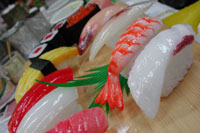 Nagao got his start in the late '60s when he became involved in the family business. For about six years he learned the technique for making the silicon molds. He then spent the next five years perfecting how to assemble the paraffin pieces and apply the finishing touches. Nagao Shoken was later established in 1980 with Nagao as chief proprietor.
Nagao got his start in the late '60s when he became involved in the family business. For about six years he learned the technique for making the silicon molds. He then spent the next five years perfecting how to assemble the paraffin pieces and apply the finishing touches. Nagao Shoken was later established in 1980 with Nagao as chief proprietor.
Izakayas, supermarkets, and restaurants all across Japan are his primary customers, though he has filled orders for sushi restaurants in Australia. Perhaps his most interesting charge was a department store that requested he create synthetic worms for a before-and-after display exhibiting the effectiveness of an insecticide. Tourists can find his miniature pudding bowls and slices of pizza dangling from the end of mobile phone straps (for 800 yen) when visiting souvenir shops at Narita Airport.
Nagao's three decades in the business has not changed the way he views real food. But he will admit that he does more than casually look at the models when he is dining out.
"I often wonder if chef can make the dish look as good as the model in the window," he says.
Note: Natsuki Fukuda contributed to this report from the Tokyo Bureau.

